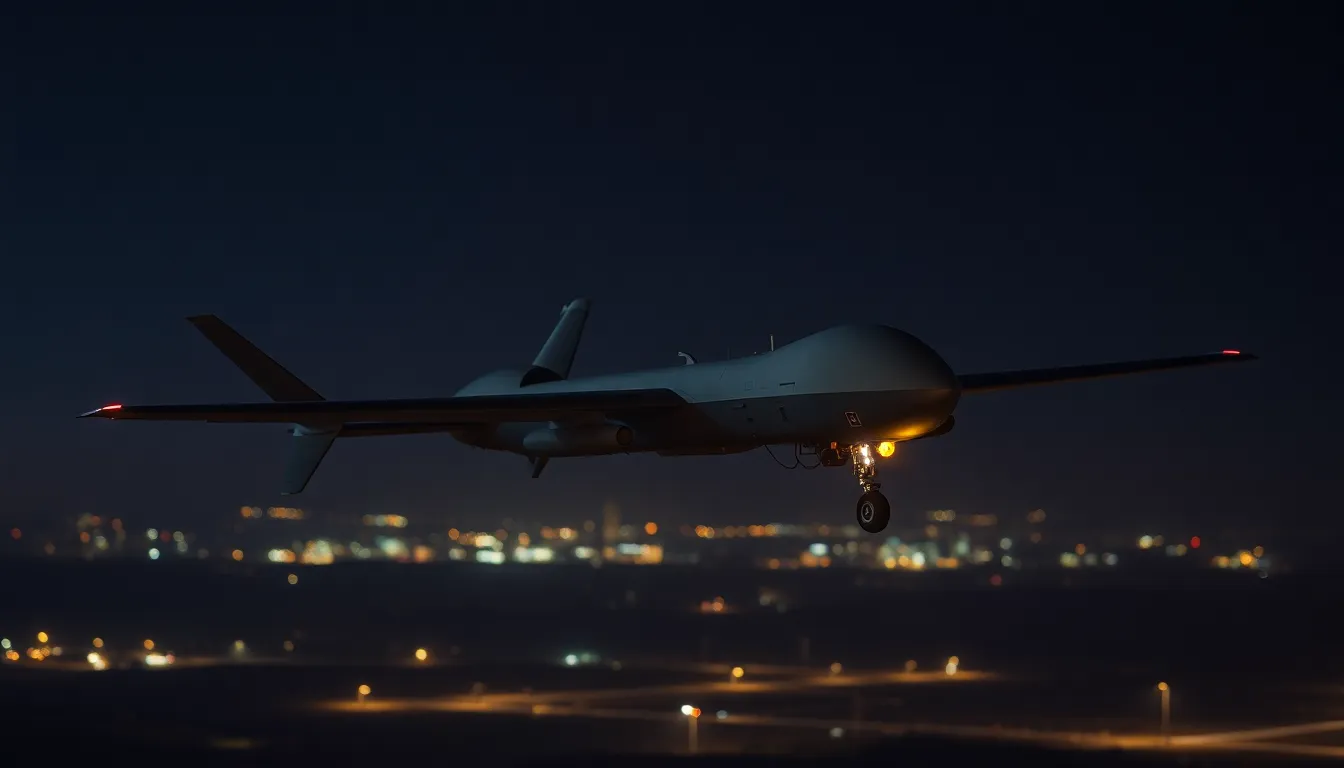When the sun sets and darkness blankets the battlefield, military drones take to the skies like stealthy owls on a mission. These high-tech marvels don’t just have a knack for surveillance; they’re the ultimate night owls, equipped with advanced technology that makes them the superheroes of the night. Imagine a flying gadget that can see in the dark, gather intel, and deliver precision strikes—all while you’re cozying up with a cup of coffee.
As the military embraces these nocturnal wonders, the game of warfare transforms. Drones are changing the way operations unfold under the cover of darkness, making it easier to outsmart the enemy. So buckle up, because the night is no longer a time for rest; it’s a thrilling arena where innovation meets strategy, and the stakes are higher than ever.
Table of Contents
ToggleOverview of Military Drones at Night
Military drones play a vital role in nighttime operations. Enhanced sensors and advanced technologies allow these aircraft to operate effectively in low-light conditions. Surveillance capabilities increase significantly after dark, providing real-time intelligence to ground forces.
Thermal imaging and infrared cameras facilitate the detection of heat signatures, even in complete darkness. This technology enables drones to identify targets and monitor enemy movements without being easily spotted. Mission success correlates directly with the ability to gather data during nighttime hours.
Various drone models, such as the MQ-1 Predator and MQ-9 Reaper, feature different specifications tailored for night operations. These models support diverse missions, including reconnaissance, combat, and search and rescue efforts. Nighttime engagement relies heavily on drones for precision strikes, significantly reducing collateral damage.
Enhancements in communications technology ensure coordination among units remains seamless during nocturnal missions. Drone operators utilize advanced software to analyze incoming data efficiently, making rapid decisions based on real-time information. Integration of artificial intelligence further optimizes flight paths and target selection, contributing to mission efficacy.
Nations worldwide increasingly recognize the importance of nighttime drone capabilities. As military strategies evolve, reliance on these aerial assets continues to grow, emphasizing a tactical advantage during darkness. Night operations present unique challenges, yet the advancements in drone technology facilitate improved effectiveness in modern warfare scenarios.
Technology Behind Night Operations

Military drones utilize advanced technologies to excel in nighttime missions. These innovations enhance effectiveness in low-light environments, ensuring precision and reliability.
Infrared Imaging
Infrared imaging plays a crucial role in nighttime operations. It detects heat signatures emitted by objects, allowing drones to spot vehicles and personnel even in complete darkness. Various models leverage this technology, providing real-time video feeds that assist operators in identifying targets and monitoring potential threats. Enhanced resolution increases clarity, making it easier to distinguish between friend and foe during critical missions. Infrared systems also minimize the risk of detection, giving military drones an advantage in stealthy engagements.
Night Vision Systems
Night vision systems contribute significantly to drone functionality during nighttime operations. These systems amplify available light, permitting clear visuals in low-light settings. By converting visible light to electronic signals, drones become capable of operating effectively with minimal illumination. Advanced night vision technology includes image intensification and low-light cameras, which provide operators with improved situational awareness. High-performance models, like the MQ-9 Reaper, integrate these systems seamlessly while supporting missions that demand accuracy and strategic insight.
Advantages of Nighttime Surveillance
Nighttime surveillance through military drones offers crucial tactical advantages. These benefits stem from various enhanced technologies, enabling effective operations in low-light situations.
Enhanced Operational Capability
Enhanced operational capability is a defining feature of drones used at night. They utilize advanced sensors that allow for effective intelligence gathering and reconnaissance in darkness. Drones like the MQ-9 Reaper deliver real-time data while flying at higher altitudes, ensuring broad coverage of target areas. Operators can monitor enemy movements and strategize accordingly, leading to improved mission planning. Night-specific features, such as thermal imaging, allow military drones to detect and identify vehicles and personnel with precision. The integration of artificial intelligence optimizes these operations, streamlining processes and improving decision-making speed.
Reduced Enemy Detection
Reduced enemy detection emphasizes the stealth capabilities of drones during nighttime missions. Drones equipped with infrared cameras minimize the chance of being spotted by adversaries. They identify heat signatures from potential targets even in complete darkness, enhancing operational security. The quiet operation of these drones limits the likelihood of alerting enemies, allowing military forces to conduct prolonged surveillance sessions. Furthermore, enemies struggle to counteract these technologies, giving the drone operators a psychological edge in engagements. Overall, nighttime surveillance by military drones provides a strategic benefit in maintaining the element of surprise.
Challenges Faced by Military Drones at Night
Military drones encounter various challenges during nighttime operations, impacting their effectiveness and overall mission success.
Limited Battery Life
Limited battery life presents a significant challenge for military drones at night. Operating in low-light conditions often requires more energy due to increased use of advanced sensors and cameras. Drones like the MQ-9 Reaper can fly for approximately 27 hours, but harsh nighttime conditions can decrease this duration. Extended missions may force pilots to make difficult decisions about engagement strategies. Constraints on battery capacity reduce both endurance and operational flexibility. Ensuring drones return safely within operational limits becomes critical in each mission.
Adverse Weather Conditions
Adverse weather conditions pose a serious risk for nighttime drone operations. Rain, fog, and strong winds can severely limit visibility and sensor performance. Drones equipped with infrared cameras can detect heat signatures, yet dense fog can obscure these capabilities. Operational effectiveness decreases significantly in such scenarios, prompting mission reassessments. The MQ-1 Predator, while efficient in clear conditions, struggles with reliability during inclement weather. Pilots must account for these factors when planning and executing nighttime missions.
Notable Examples of Nighttime Operations
Military drones have demonstrated remarkable effectiveness in various nighttime operations. Notably, the MQ-1 Predator has executed numerous reconnaissance missions after dark, delivering crucial intelligence on enemy movements. Similarly, the MQ-9 Reaper has supported combat operations, utilizing its advanced targeting systems to conduct precision strikes under the cover of darkness.
Infrared technology has played a pivotal role in these missions. This capability allows drones to detect thermal signatures, identifying targets even when visibility is low. Real-time video feeds from these drones enhance situational awareness, enabling operators to make informed decisions swiftly.
Operations in conflict zones exemplify the advantages of nighttime drone use. For instance, during the conflict in Syria, military commanders relied on MQ-9 Reapers for intelligence gathering and combat support, utilizing their stealth capabilities to evade enemy detection. Such examples illustrate the strategic superiority gained through nighttime capabilities.
Challenges do arise as well. Battery life remains a concern for sustained nighttime missions. Operating in low-light conditions often drains power more rapidly, necessitating careful planning to ensure mission success. Additionally, weather conditions can impact performance; heavy fog or rain can hamper visibility, prompting reassessments of operational feasibility.
Each mission reinforces the importance of advanced technology in military drones. Enhanced sensors and improved communication systems continue to elevate the standards for nighttime operations. As conflicts evolve, the reliance on these capabilities reflects their essential role in modern warfare.
Military drones have revolutionized nighttime operations by providing unparalleled surveillance and precision capabilities. Their advanced technologies enable effective missions in low-light conditions while minimizing risks to personnel and collateral damage. The integration of thermal imaging and artificial intelligence enhances their operational efficiency, allowing for real-time data collection and informed decision-making.
Despite challenges like battery life and adverse weather, the strategic advantages of using drones at night are undeniable. As conflicts evolve and the need for stealthy reconnaissance grows, military drones will continue to play a crucial role in modern warfare. Their ability to operate under the cover of darkness ensures that military forces maintain a tactical edge in increasingly complex environments.


